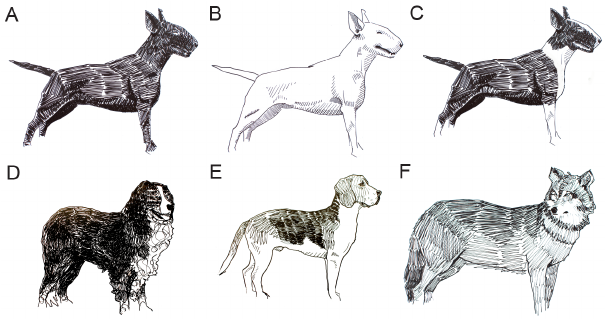✅ The Effects of Genetics on Canine Morphology

Breed standards emerged before our current understanding of canine genetics could provide us with the information we have today, and were drawn up based on the observation of type versus function. But in artificial selection, such as that used in dog breeding, how much might genetics have influenced morphology and therefore the breed standard?
👉 A significant example arises from the simple observation that dog breeds come in a wide variety of shapes and sizes. Dwarfism, or skeletal dysplasia, characterizes many dog breeds and was selected to slow the speed of hunting dogs, allow them to enter small dens to chase game, and reduce the overall size of companion dogs (www.fci.be and www.akc.org (updated January 25, 2021)). Two different FGF4 retrogenes have been associated with dwarfism in dog breeds. Interestingly, the most common form of human dwarfism is caused by recurrent activating mutations in the FGFR3 gene.
- Two FGF4 retrogenes (FGF4L1 on chromosome 18 and FGF4L2 on chromosome 12) have been identified as causing dwarfism in many dog breeds. Some breeds are almost entirely homozygous for both retrogenes (e.g., Dachshunds), while others are homozygous for only one (e.g., Beagles and Scottish Terriers).
Because most breeds do not segregate both of these retrogenes, it is difficult to assess their individual effects on long bone length and body size.
Two dog breeds selected for hunting ability, the Alpine Dachsbracke and the Swiss Short-haired Pointer, have been identified as segregating both of these retrogenes. ➡️ ⬅️ Using individual integrated morphometric measurements of shoulder height, back length, head width, chest depth and width, and thoracic limb measurements, the combined effects of FGF4retrogenes were evaluated within these breeds.
Through the application of multivariable linear regression analysis to determine the effects of retrogene copy numbers on the measurements.
The copy number effect of both retrogenes was significant, reducing shoulder height and antebrachial length, FGF4L1 having a much greater effect than FGF4L2.
FGF4L1 alone influenced the degree of carpal valgus, and FGF4L2 alone increased head width. Neither retrogene had an effect on chest width or depth.
🖲 Selective breeding of dogs with FGF4L1 and without FGF4L2 would likely lead to a reduction in the FGF4L2-related risk of intervertebral disc herniation while maintaining the reduction in leg length resulting from FGF4L1.
✅ DOG SHOWS AND MISINTERPRETATIONS
- It should be noted that some show judges tend to promote dogs with a shorter humerus than the original standard dictates, as in the Boston Terrier, where a short humerus penalizes the Top Line, a characteristic that, along with the ratio of the skull bones, represents the salient characteristics of the breed. Similarly, in the Jack Russell Terrier, dogs with a longer humerus than the official standard are judged with condescension, deeming them unsuitable for breeding. However, a good breeder knows that in the second or third generation, the same dog can easily produce offspring that are not dyscrasic compared to the parameters set by the current breed standard, also by virtue of the above.
✔️ It would therefore be appropriate for Show Judges to adhere to a morphological evaluation based on a type preferably adopted and compiled in the country of origin using phenotypic parameters, without making considerations that involve genotypic evaluations, which require a range of knowledge that cannot be explored in a show ring.
(REPROVETgenetics ITALIA)
☑️ Authors:
Francesco Micoli, Danika Bannasch, Kevin Batcher, Fabienne Leuthard, Michele Bannasch, Petra Abbraccio, Denis J. Marcellin-Little, Peter J. Dickinson, Michaela Drögemüller, Cord Drögemüller, Tosso Leeb.
